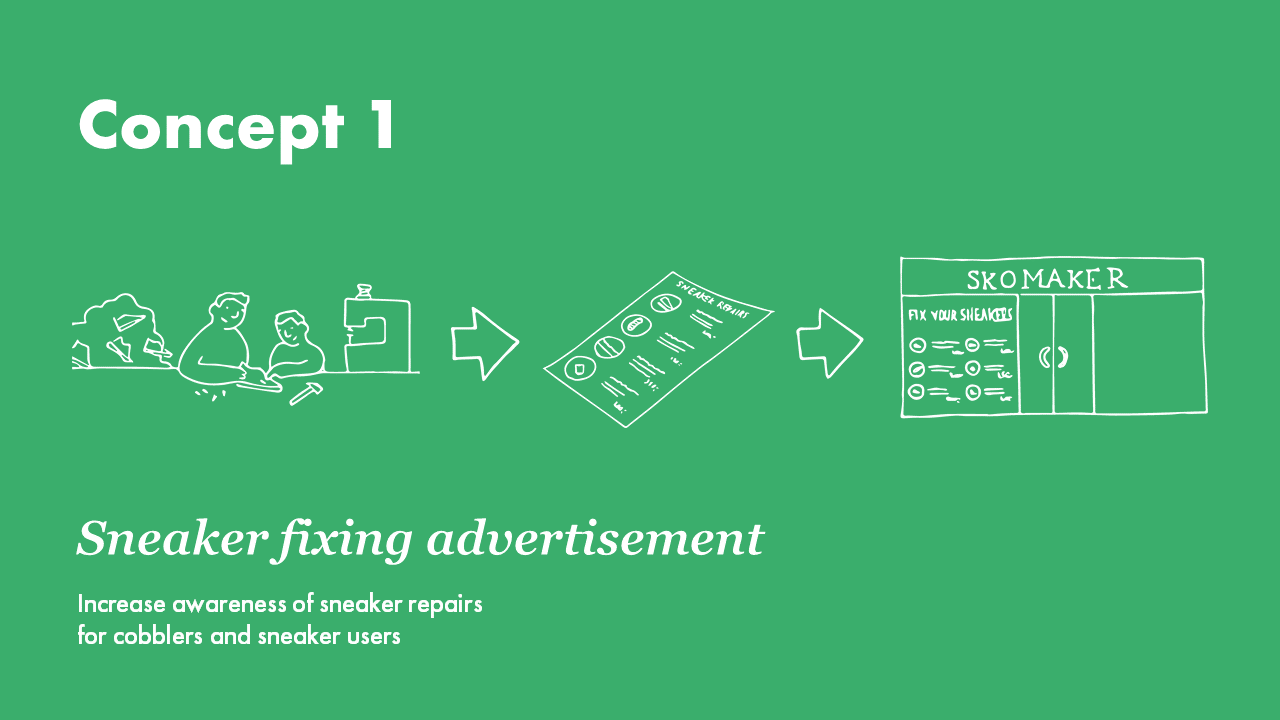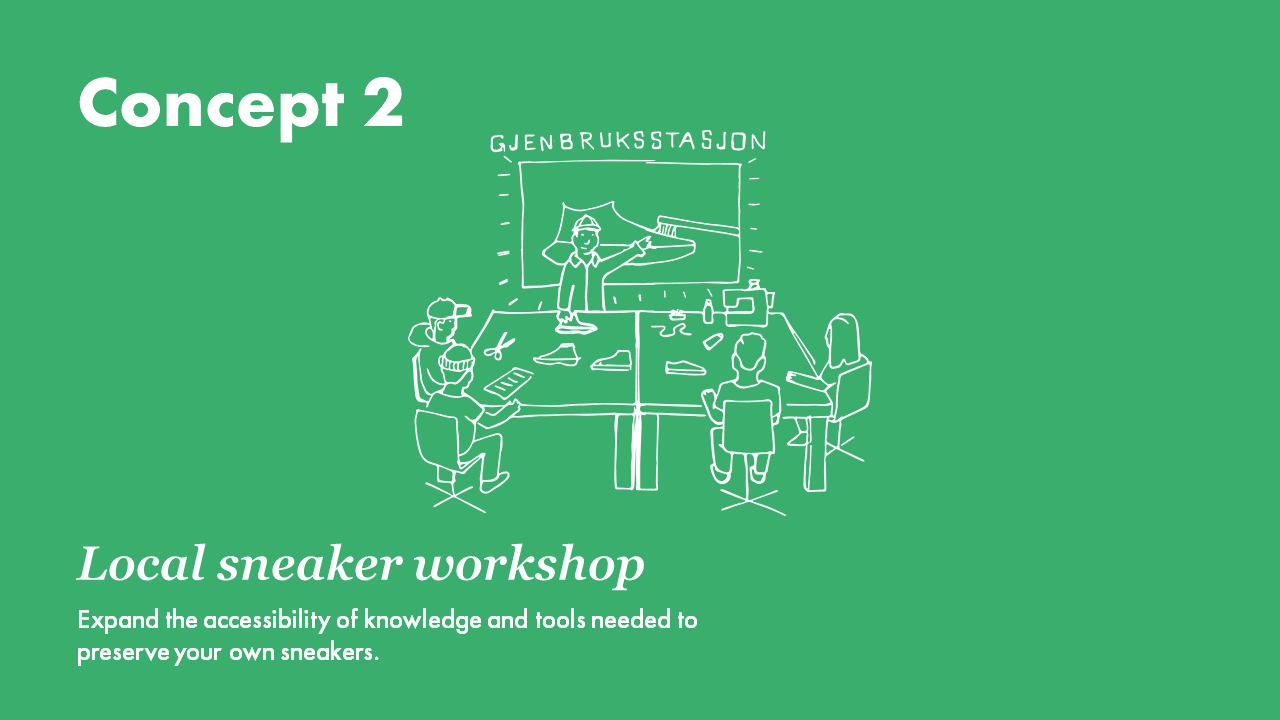Fixing Sneakers
Fixing Sneakers was my Masters thesis project, completed at The Oslo School of Architecture and Design (AHO). The goal of my thesis was to see what service design could do to motivate people in Oslo to consume sneakers in a more sustainable way.
The delivery consisted of three developed and tested service concepts. For each of these, I collaborated with different key actors in the city: local cobblers, the municipality, and Fretex, Oslo’s biggest second-hand apparel collecter and seller. I took a hands-on approach, producing high fidelity prototypes quickly in order to gather valuable feedback.
The project was nominated for Best Diploma Project, and I continue to work with Fretex on the development and implementation of the project’s key concepts. Scroll down for snapshots of the process, or read the report PDF.
Project by: Jacob Pettersen
Project length: 4 months
AHO course: Diploma/Master’s thesis, Fall 2019
Motivation
I wanted to work with sneakers and service design because I saw that despite the increasing popularity of sneakers, sneakers were often overlooked in projects dealing with apparal and sustainability.
Adidas is working on making recycleable sneakers but they say that it will take some time before this kind of sneaker become a market standard. My project looks at what we can do in the meantime to motivate people in Oslo to consume sneakers in the most sustainable way possible.
Sustainable Consumption?
So what is a more sustainable way to consume sneakers? Through my early research on sustainability and sneakers, I found that the majority of CO2 emissions and water pollution from a sneaker lifecycle comes from the manufacturing stage. This could be addressed by encouraging people to buy fewer new shoes.
Through my research, I also found that buying “eco-sneakers” has a limited impact, and that Norwegians own 12 pairs of shoes but are only using 6 of them, indicating that we buy too many pairs and our consumption can and should be constrained.
So what are actions to prevent us from buying new sneakers? We can for example buy used sneakers or repair or clean the ones we have.
Talking With People in the Streets
So I went out in the street and interviewed 7 people using my fictional service, Cleaning Sneakers, as a way to engage them about their sneaker habits and see how they would react to a sneaker care service.
I received feedback like:
Most people don’t know that most cobblers repair sneakers.
People would like to have equipment available so they can clean and repair their sneakers themselves.
People don’t buy sneakers at second-hand stores because they usually don’t find the size and style they wanted.
Talking with Cobblers
I spoke to seven cobblers, six of whom said that they repair sneakers. I had a special relationship with a cobbler named Hosan, who told me that he wanted to repair more sneakers but that they were a very small percentage of the shoes coming in.
Talking with Fretex
Åse is the head of Fretex’s sorting facility in Oslo, the biggest actor in the sorting and reselling of used clothing and shoes in Norway. She says that there is demand in Fretex stores for more good sneakers, however they don’t find enough quality sneakers in what they are able to review every day; they get approximately 30 tonnes of clothes and shoes to their facility daily but they only have the capacity to sort through 5 tonnes.
She said that if they had separate shoe collecting boxes they would be better able to communicate how customers should deliver their shoes, be able to sort through more inventory, and as a result, find more quality sneakers they can resell.
Mapping & Ideation
I mapped out all my insights from my research and interviews and found some opportunity areas.
From these opportunity areas, I sketched out as many ideas as I could. I evaluated these ideas based on how many insights supported each idea and how much effect they would have compared to how easy they would be to implement.
The Concepts
The three concepts I chose from my ideation process were: a sneaker fixing advertisement to make it more visible to potential customers that cobblers can repair sneakers; a sneaker repair workshop supported by the municipality to make it cheaper and more accessible to repair your own shoes; and finally a series of touchpoints to help Fretex sell more used sneakers. This final concept included implementing separate shoe collecting boxes and a dedicated Fretex shoe shop which I wanted to test by hosting a sneaker pop-up in a Fretex store.
Concept 1 - Sneaker Fixing Advertisement
For the cobblers, I made a flyer/poster hybrid which shows the categories of repairs cobblers can perform, as well as what you can do to restore your sneakers yourself. Hosan the cobbler was pleased, and other cobblers I showed it to also liked it, but it would need further iterations in order to be more flexible to the various needs of different cobblers.
Concept 2 - Local Sneaker Workshop
I hosted the workshop in a community event and recycling center in Oslo. Approximately12 people showed up, among them seven 15 year old boys, a demographic not typically reached by other services dealing with clothes and sustainability. The workshop went well and everybody was excited to fix their things. This made me believe that this could be scaled up to a permanent communal sneaker fixing workshop.
Concept 3 - Shoe Collection Box
For Fretex, I designed a shoe collecting box which we are now working on testing in the streets. I also designed the communication on the front of the of the box which helps the donor understand how to deliver their shoes in the best possible way for Fretex. I also translated this information into social media content, which is also an important and easy way for Fretex to reach out to their customers.
Concept 3 - Sneaker Pop-Up
I also arranged a sneaker pop-up shop in a Fretex store in downtown Oslo where we sold cool sneakers we had collected over the course of a month. We also collected shoes that might typically be too dirty for Fretex to sell, in order to see what little I needed to do to make them sellable. It was a great success, with almost 200 pairs sold in two days. I cleaned around 40 pairs of shoes, taking about 10 min on each pair. In one day, the pop-up earned double the amount of the store’s usual revenue for a normal Friday. This may indicate that Fretex could open a separate shoe store, making it easier and more attractive to buy used sneakers.



